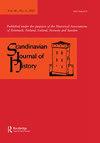妇女的仪式:重新发现丹麦的教堂仪式,约1750-1965年
IF 0.8
3区 历史学
Q1 HISTORY
引用次数: 0
摘要
摘要本文以丹麦为例,追溯了1750年至1965年的女性产后教堂仪式。教堂为女性的宗教信仰和对生殖身体的感知提供了一个新的视角。教堂位于宗教和日常生活的交叉点,既是一种牧师仪式,也是一种处于公共生活中心的社会习俗,也是已婚母亲的节日。植根于利未记中的分娩不洁,被用作基督教的净化仪式,然后被路德改革者重新定义为感恩仪式,在欧洲的许多地方,教堂活动一直沿着平行的轨道持续到19世纪和20世纪。然而,在丹麦和其他地方一样,去教堂已经不再是人们的共同记忆。这篇文章首先考察了牧师仪式,展示了教堂是如何提升母亲在会众中的地位,为她提供时间、空间和荣誉的,而当教堂停止时,她失去了这一地位。第二部分分析了社会对女性施加不同规范时,从怀孕到去教堂的生育周期。分娩是危险的,身体的脆弱性加上对恶灵的普遍恐惧和不纯感。与其说是一个简单的感恩仪式,去教堂往往代表着一条回归安全的平淡而治愈的通道。本文章由计算机程序翻译,如有差异,请以英文原文为准。
A woman’s rite: rediscovering the ritual of churching in Denmark, c. 1750-1965
ABSTRACT Taking Denmark as a case study, this article retraces the ritual of churching of women after childbirth 1750c-1965. Churching offers a new angle into women’s religiosity and perception of their procreative body. Placed at the intersection of religion and everyday life, churching was as much a clerical ritual as a social custom at the centre of communal life and a feast day for the married mother. Rooted in Levitical childbirth impurity, adopted as a Christian purification ritual, then redefined by Lutheran reformers as a thanksgiving rite, churching continued along parallel tracks in Europe into the nineteenth and twentieth century in many places. Yet churching has fallen out of common memory in Denmark as elsewhere. This article first examines the clerical rite, demonstrating how churching elevated a mother’s status in the congregation, affording her time, space and honour, a position she lost when churching ceased. The second part analyses the childbirth cycle from pregnancy to churching when society imposed different norms on women. Childbirth was dangerous and physical vulnerability compounded by widespread fears of evil spirits and a sense of being impure. Rather than simply a thanksgiving ceremony, churching often represented an apotropaic and healing passage back to safety.
求助全文
通过发布文献求助,成功后即可免费获取论文全文。
去求助
来源期刊

SCANDINAVIAN JOURNAL OF HISTORY
HISTORY-
CiteScore
1.10
自引率
20.00%
发文量
33
期刊介绍:
Scandinavian Journal of History presents articles on Scandinavian history and review essays surveying themes in recent Scandinavian historical research. It concentrates on perspectives of national historical particularities and important long-term and short-term developments. The editorial policy gives particular priority to Scandinavian topics and to efforts of placing Scandinavian developments into a larger context. Studies explicitly comparing Scandinavian processes and phenomena to those in other parts of the world are therefore regarded as particularly important. In addition to publishing articles and review essays, the journal includes short book reviews. Review essay proposals and polemical communications are welcomed.
 求助内容:
求助内容: 应助结果提醒方式:
应助结果提醒方式:


